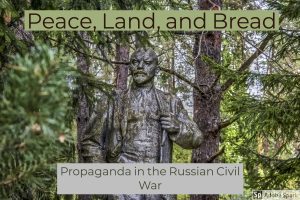Description:
This mini-lesson is designed to take place within the later portion of a Russian Revolution unit of a Modern World History course. Ideally the students would have already covered the events leading up to the Civil War. Background knowledge required would be conditions that led to the Revolution, The Russian
In this lesson we will look at Russian propaganda posters from the Russian Civil War (1917-1922). Due to the low rate of literacy before the Russian Revolution, visual art played a pivotal role in conveying ideas to the unlettered. Students will be put into the role of the Russian peasantry and asked to not only analyze the source, but also find context within the larger scope of the Russian Revolution. Each poster shall be examined individually before returning to discuss the two as a larger group. The primary goal shall be to examine depictions of the Bolshevik party during the Russian Civil War. Students will make connections to previous lessons and contrast the images we analyze with their previous knowledge of the period.
Sources:
The first poster we will examine depicts the ‘inevitable’ rise in the Bolshevik’s fortunes throughout the Civil War. It is likely a anniversary poster of the October Revolution with the text reading, “Hail to the Universal Red October”.
What stands out to you in this poster? Who do you think was the posters intended audience?
Why is the poster divided into the panels? What are the differences between the two scenes?
What do you think is the intended message of this poster? What does this say about the Bolshevik movement?
This next poster was created by the White Army. It is entitled “Communist Paradise”. The top panel depicts the Bolshevik Central Committee, while the bottom panel gives the reader an image of the Ukraine.
What does the top panel say about the Bolshevik leadership? How does this image compare with the previous depiction of the Bolshevik party?
How does the bottom panel depict life in the Soviet Union? Who do you think is blamed for the conditions depicted?
How does the image of the Bolsheviks contrast with their own propaganda poster? Which image do you find more credible?
Do you think these images
Reflection:
I enjoyed writing this lesson, but feel that I struggled in finding and analyzing visual resources. One of the difficulties that I encountered is the amount of context required when examining pictorial sources from this period.It is easy to take background knowledge for granted,and as I walked myself through the lesson I felt fairly unsatisfied with the result. I think this lesson could be successful within a high school classroom, though to be perfectly honest analyzing WW1 propaganda posters would probably be a stronger activity. I did greatly enjoy going through digital reams of propaganda posters, the stark colors and spare design of posters from this era are always a joy to look through.
Link for Source 1:
Slavic and East European Collections, The New York Public Library. (1917 – 1921). Oktiabr’ 1917 – Oktiabr’ 1920. Da zdravstvuet Vsemirnyi Krasnyi Oktiabr’! Retrieved from http://digitalcollections.nypl.org/items/510d47de-83c2-a3d9-e040-e00a18064a99
Link for Source 2:
White Army Poster, The British Library. (2009, May 07). Retrieved from http://www.bl.uk/learning/citizenship/campaign/myh/posters/gallery1/poster6/whitearmy.html




I love propaganda posters. Here’s a site (in Russian) that pairs Soviet and Nazi posters of the same era http://fototelegraf.ru/173168-plakaty-sssr-i-tretego-rejxa-sravnenie.html
This is awesome. The uniquely Russian propaganda is definitely a cool way to make this lesson different than other lessons about propaganda they may have seen before.
Nice lesson! I can relate to your reflection; it can be a challenge to find the right visual resource for our students to analyze. I really enjoy how you honed your focus in on Russia, because what an important part of history that was.
I really like how you use propaganda in a lesson as a visual source and going over what is depicted in it and what this means. I also think that’s its really cool that your lesson deals with Russian history as well because I think that its rarely explored in schools.